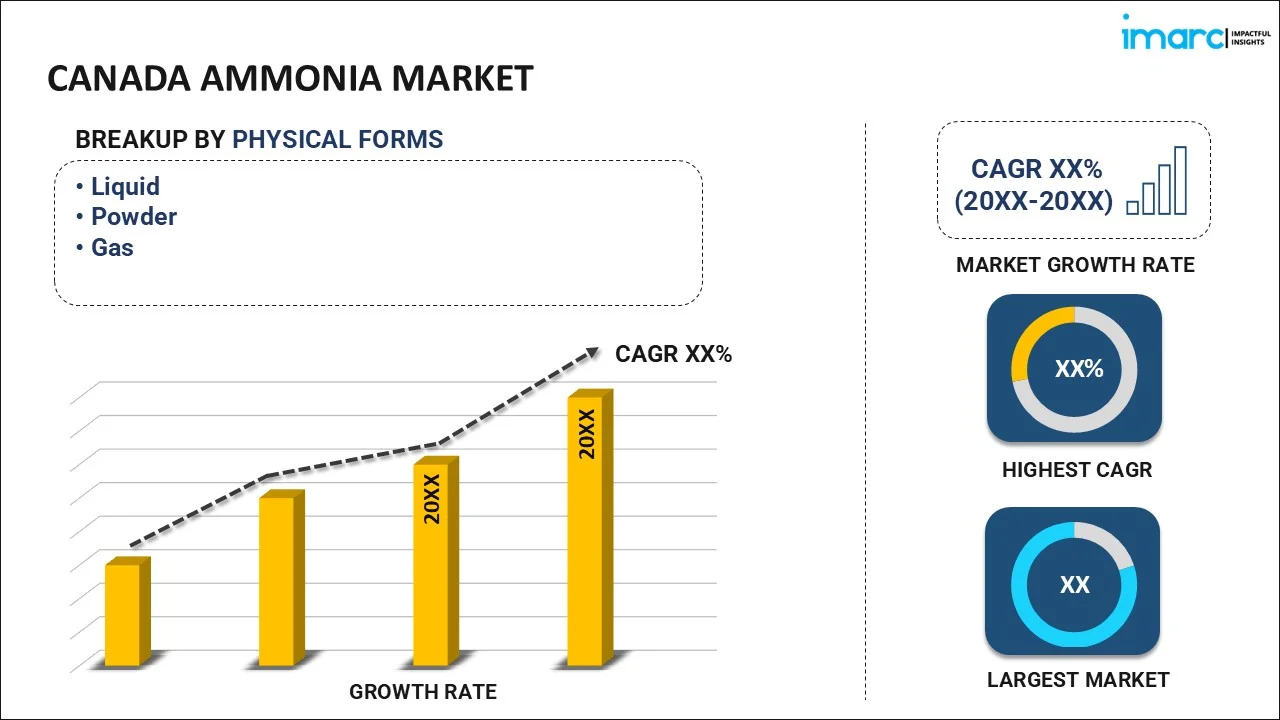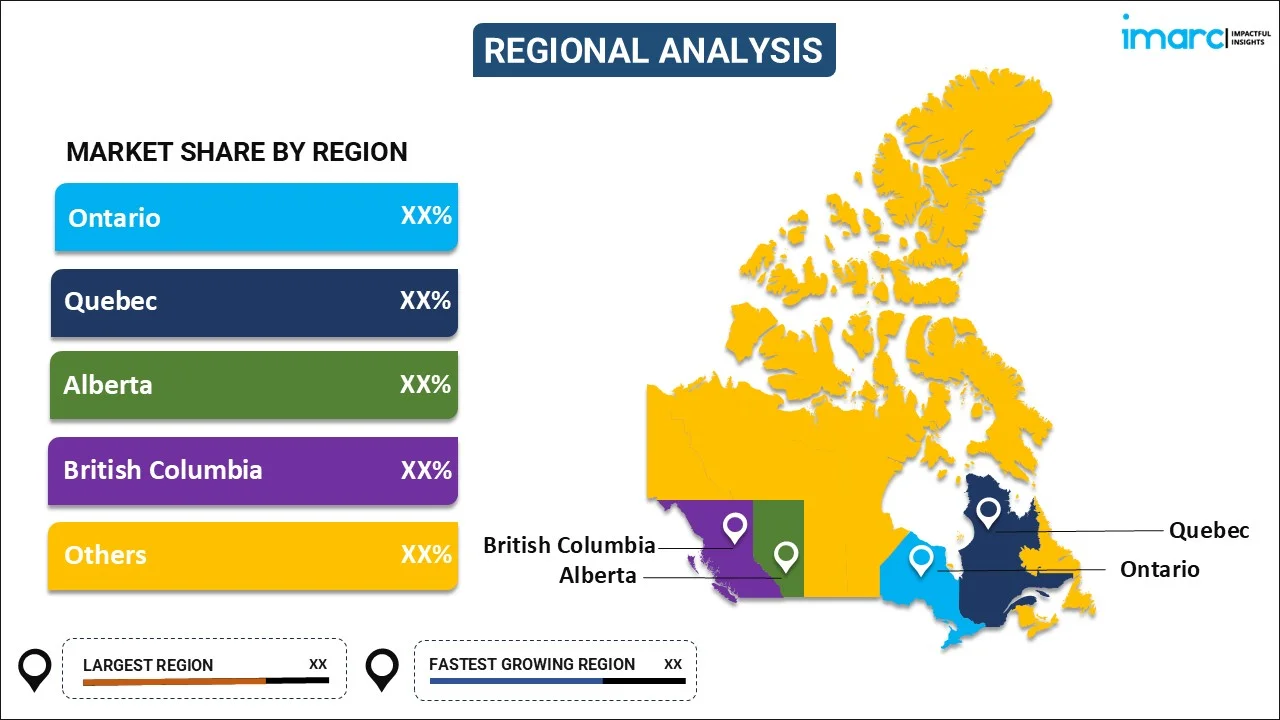
Canada Ammonia Market Size, Share, Trends and Forecast by Physical Form, Application, End Use Industry, and Region, 2025-2033
Canada Ammonia Market Overview:
The Canada ammonia market size reached 3.44 Million Tons in 2024. Looking forward, IMARC Group expects the market to reach 4.92 Million Tons by 2033, exhibiting a growth rate (CAGR) of 3.60% during 2025-2033. Strong industrial applications, thriving agricultural demand, and strict environmental policies are driving the market, which is expected to grow as a result of enhancing product incorporation in fertilizers, refrigeration systems, chemical synthesis, drug manufacturing, and sustainable technologies.
|
Report Attribute
|
Key Statistics
|
|---|---|
|
Base Year
|
2024 |
|
Forecast Years
|
2025-2033
|
|
Historical Years
|
2019-2024
|
| Market Size in 2024 | 3.44 Million Tons |
| Market Forecast in 2033 | 4.92 Million Tons |
| Market Growth Rate (2025-2033) | 3.60% |
Canada Ammonia Market Trends:
Agricultural Demand
Ammonia plays a significant role in the production of nitrogen-based fertilizers, which are essential for the growth and productivity of crops. In order to sustain and enhance productivity, Canada's extensive agricultural landscape, which includes key crops like wheat, canola, and barley, primarily depends on these fertilizers. In order to meet demand from both domestic and international markets, the country's farmers are also continuously experimenting with new ways to boost agricultural yield. As a result, there is a greater need for ammonia and fertilizers containing ammonia. Additionally, the ongoing push towards sustainable agriculture practices, leading to an increased use of ammonia in controlled-release fertilizers, which improve nutrient uptake efficiency and reduce environmental impact, is boosting the market growth. For instance, industry reports suggest that in 2023, sustainable farming practices reduced greenhouse gas emissions by 11 megatonnes of carbon dioxide equivalent (Mt CO2e) in Canada. Moreover, by 2030, Natural Climate Solutions (NCS), including sustainable agriculture in Canada, could sequester up to 78 Mt CO2 annually, making a substantial impact toward meeting the Paris Agreement targets. This change is in line with the worldwide trend of sustainable agricultural practices and helps farmers not only increase crop yields but also promote environmental sustainability initiatives.
Industrial Applications
Ammonia is commonly used in refrigeration systems, especially large-scale industrial refrigeration units used in food processing factories, cold storage warehouses, and ice-making facilities. Its efficiency as a refrigerant, paired with its inexpensive cost, makes it a popular choice in many industries. Additionally, ammonia is a key ingredient in the production of various chemicals, including urea, which is used in a variety of industrial applications such as adhesives, resins, and plastics. The pharmaceutical industry also utilizes ammonia in the synthesis of certain drugs and intermediates, highlighting its versatility. For instance, according to the official data from the Government of Canada, the country accounts for 2.2% of global pharmaceutical sales, ranking as the world's eighth-largest market. Therefore, the robust growth of these industrial sectors in Canada, driven by increasing demand for processed foods, pharmaceuticals, and chemicals, directly translates to higher ammonia consumption.
Environmental Regulations
Environmental regulations are a significant catalyst for the growth of the ammonia market in Canada. Government and regulatory bodies are implementing stricter environmental policies to combat climate change and reduce greenhouse gas (GHG) emissions. For instance, in December 2024, Canada updated its emissions reduction goal to 45–50% below 2005 levels by 2035, expanding on the earlier 40–45% target for 2030. Additionally, the government delayed its net-zero electricity grid target from 2035 to 2050, revising its Clean Electricity Regulations. These regulations aim to cut 181 megatonnes of carbon emissions by 2050. This has compelled industries to adopt more sustainable practices. Ammonia is recognized as an environmentally friendly alternative, particularly in refrigeration systems, due to its zero-ozone depletion potential and low global warming potential. This has led to a shift from traditional hydrofluorocarbon (HFC) refrigerants to ammonia-based systems in various industries. Additionally, ammonia is being explored as a potential fuel source and energy carrier, particularly in the context of the hydrogen economy. Green ammonia, produced from renewable energy sources, offers a carbon-free energy solution, aligning with global sustainability goals.
Canada Ammonia Market Segmentation:
IMARC Group provides an analysis of the key trends in each segment of the market, along with forecasts at the region/country level for 2025-2033. Our report has categorized the market based on physical form, application, and end use industry.
Physical Form Insights:

- Liquid
- Powder
- Gas
A detailed breakup and analysis of the market based on the physical form have provided have also been provided in the report. This includes liquid, powder, and gas.
Application Insights:
- MAP and DAP
- Urea
- Nitric Acid
- Ammonium Sulfate
- Ammonium Nitrate
- Others
A detailed breakup and analysis of the market based on the application have provided have also been provided in the report. This includes MAP and DAP, urea, nitric acid, ammonium sulfate, ammonium nitrate, and others.
End Use Industry Insights:
- Agrochemical
- Industrial Chemical
- Mining
- Pharmaceutical
- Textiles
- Others
A detailed breakup and analysis of the market based on the end use industry have provided have also been provided in the report. This includes agrochemical, industrial chemical, mining, pharmaceutical, textiles, and others.
Regional Insights:

- Ontario
- Quebec
- Alberta
- British Colombia
- Others
The report has also provided a comprehensive analysis of all the major regional markets, which include Ontario, Quebec, Alberta, British Colombia, and others.
Competitive Landscape:
The market research report has also provided a comprehensive analysis of the competitive landscape. Competitive analysis such as market structure, key player positioning, top winning strategies, competitive dashboard, and company evaluation quadrant has been covered in the report. Also, detailed profiles of all major companies have been provided.
Canada Ammonia Market News:
- In March 2024: Yara International ASA collaborated with GHC SAOC, a subsidiary of Acme Cleantech. Under this arrangement, Yara will receive 100,000 tons of ammonia annually from Acme with reduced carbon dioxide emissions.
- In December 2023: CF Industries Holdings Inc. acquired Incitec Pivot Limited’s Waggaman ammonia production facility for US$ 1.675 billion. After this move, CF Industries will add another 880,000 tons of ammonia production annually to their existing capacity.
Canada Ammonia Market Report Coverage:
| Report Features | Details |
|---|---|
| Base Year of the Analysis | 2024 |
| Historical Period | 2019-2024 |
| Forecast Period | 2025-2033 |
| Units | Million Tons |
| Scope of the Report |
Exploration of Historical Trends and Market Outlook, Industry Catalysts and Challenges, Segment-Wise Historical and Future Market Assessment:
|
| Physical Forms Covered | Liquid, Powder, Gas |
| Applications Covered | MAP and DAP, Urea, Nitric Acid, Ammonium Sulfate, Ammonium Nitrate, Others |
| End Use Industries Covered | Agrochemical, Industrial Chemical, Mining, Pharmaceutical, Textiles, Others |
| Regions Covered | Ontario, Quebec, Alberta, British Colombia, Others |
| Customization Scope | 10% Free Customization |
| Post-Sale Analyst Support | 10-12 Weeks |
| Delivery Format | PDF and Excel through Email (We can also provide the editable version of the report in PPT/Word format on special request) |
Key Questions Answered in This Report:
- How has the Canada ammonia market performed so far and how will it perform in the coming years?
- What is the breakup of the Canada ammonia market on the basis of physical form?
- What is the breakup of the Canada ammonia market on the basis of application?
- What is the breakup of the Canada ammonia market on the basis of end use industry?
- What are the various stages in the value chain of the Canada ammonia market?
- What are the key driving factors and challenges in the Canada ammonia market?
- What is the structure of the Canada ammonia market and who are the key players?
- What is the degree of competition in the Canada ammonia market?
Key Benefits for Stakeholders:
- IMARC’s industry report offers a comprehensive quantitative analysis of various market segments, historical and current market trends, market forecasts, and dynamics of the Canada ammonia market from 2019-2033.
- The research report provides the latest information on the market drivers, challenges, and opportunities in the Canada ammonia market.
- Porter's five forces analysis assist stakeholders in assessing the impact of new entrants, competitive rivalry, supplier power, buyer power, and the threat of substitution. It helps stakeholders to analyze the level of competition within the Canada ammonia industry and its attractiveness.
- Competitive landscape allows stakeholders to understand their competitive environment and provides an insight into the current positions of key players in the market.
Need more help?
- Speak to our experienced analysts for insights on the current market scenarios.
- Include additional segments and countries to customize the report as per your requirement.
- Gain an unparalleled competitive advantage in your domain by understanding how to utilize the report and positively impacting your operations and revenue.
- For further assistance, please connect with our analysts.
 Request Customization
Request Customization
 Speak to an Analyst
Speak to an Analyst
 Request Brochure
Request Brochure
 Inquire Before Buying
Inquire Before Buying




.webp)




.webp)












